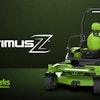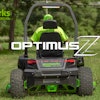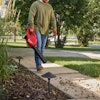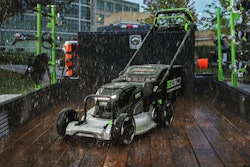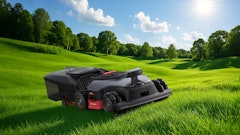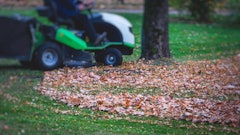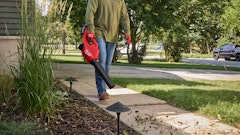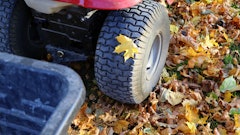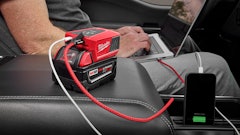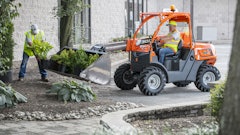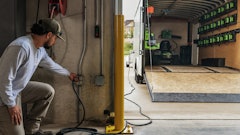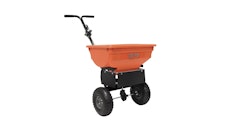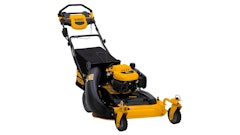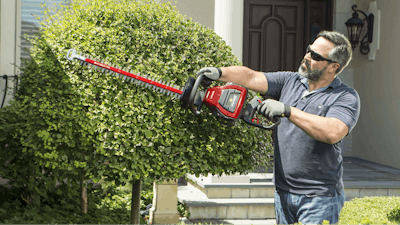
The shift from gas to battery power is steadily gaining momentum in the landscaping industry.
There is no mistaking the convenience of battery-powered lawn equipment. The market for battery-powered equipment continues to trend upward, both in the consumer and professional segment.
Over the past few years, the battery-powered outdoor power equipment (OPE) market has grown significantly and will at least match the gasoline market in the not-too-distant future. In fact, STIHL’s battery sales to dealers were up double digits in 2020.
“In line with consumer expectation, battery technology has improved vastly as well, providing users a powerful alternative to gasoline-powered equipment while offering a host of benefits including ease of use, zero exhaust emissions, reduced noise, no fuel costs and reduced maintenance,” says Mike Poluka, STIHL Inc. product manager.
Still, many pros view this product category skeptically, as they do most new technologies and overall approaches to doing business. They have questions, and do not want to find out that the answers don’t suit them in the middle of the season.
“Our data shows that in the next five years, battery will grow exponentially on the residential side of the business,” says Christina Wam, Briggs & Stratton Turf and Consumer Products director of marketing. With commercial landscapers, battery shifts will take longer to come to fruition, however there is growth within landscaper market as well.
The COVID-19 pandemic led to an increase in sales for this type of equipment, as homeowners were focused a bit more on home maintenance and other landscaping projects. “The sophisticated combination of batteries, motors, and electronics behind battery-powered equipment continues to advance, pushing the performance and adoption of battery-powered options especially within the professional market,” says Tony Buxton, Milwaukee Tool senior product manager. “We’re now at a place where many of the battery-powered options available are performing at the same level as gas options.”
There is also a system advantage for pros investing in battery-powered equipment. For instance, Milwaukee Tool’s OPE line is compatible with the M18 System which consists of more than 200 other products that use the exact same batteries. “This means that when pros invest into Milwaukee’s OPE, they’re also investing in a system that will benefit them more than just during their landscaping work,” Buxton says. Other manufacturers have similar benefits as one battery-style fits multiple tools.
“In the long term over the next few years, we expect the adoption of battery power in the professional space to gain more momentum and for it to shift over,” Buxton says.
Benefits
The potential benefits of battery power have also made these tools more appealing for pros: easy start-up, zero emissions, lower noise, and there is no gas or fuel to mix while on the job.
“First and foremost, the idea of infinite power that battery-powered equipment provides coupled with less downtime is a key advantage,” Wam says. “We see some commercial customers who use our Snapper XD 82V Max chore tools keeping extra batteries charged on an inverter generator in the truck, so they never run out of power. A quick battery swap and they are back at it. “
The comment most people make when they first experience battery-powered lawn and garden tools vs gas is how easy they are to start.
EGO’s Director of Excitement Gerry Barnaby says the turning point (in a negative way) for gas-powered tools came with the introduction of ethanol. “If you don’t stabilize the gas right out of the pump it can start to go bad in 30 days, gum up your carb which will make starting your tool harder and harder,” he says.
To start up a gas unit, the user must prime and pull start and if the equipment hasn’t been used in a while or it’s being used in a colder climate, it can be harder to get up and running.
“With battery-powered equipment there is a very simple push-button start, eliminating the time-intensive start-up process of a gas engine,” Buxton says.
Also, with no dirty air filters, spark plugs, snapped recoil starter or failing carburetors, there is no engine maintenance on battery-powered equipment. There is no tune-up, there are no additives, there’s nothing except a ‘go’ button.
Lastly, is the significantly reduced noise and no emissions coming from battery-powered tools.
There continues to be pressure on the industry from different sources to reduce emission for professional end-users, it is not uncommon to hear that municipalities, homeowner associations, or campuses prohibit the use of certain gasoline-powered equipment. There could be several reasons for these mandates, such as exhaust emissions or noise levels, and it certainly attributes to the growth in the market on the professional side.
Battery-powered equipment is a great solution. “Due to the elimination of the gas engine, battery-powered equipment creates substantially less noise,” Buxton says. “Many landscaping crews focus on residential and commercial areas where there may be a need to create less noise, so they do not bother or distract occupants and neighbors.”
Additionally, he says the reduction in noise is beneficial on the operator’s long-term hearing because they are not exposed to high noise levels continuously throughout the day.
“Furthermore, battery-powered equipment has no exhaust system so users do not have to deal with emissions blowing into their face or heat build-up on exhaust pipes, both commonly noted frustrations,” Buxton says.
In the Running
Despite their growing popularity, many landscape contractors are reluctant to give up their gas-powered equipment for rechargeable ones, having concerns about their initial cost, performance, and run time.
“The argument still exists, but as we see batteries taking over in other sectors, I think we’ll hear it from fewer and fewer landscapers,” Wam says. “We’re seeing commercial jackhammers operated by battery, whole home batteries and obviously battery-powered cars are now commonplace. If battery can power all these things and more, then I think landscapers will come to appreciate the role battery can play in their equipment line-up.”
Indeed, it appears that most manufacturers are closing the gap on gas-powered tools.
“We expect the power and runtime of battery powered products to eclipse gas handheld products in the next few years,” Buxton says. “We have proven through our battery-powered technology, that we can deliver users the ability to complete applications faster than small gas engines up to 40cc.”
Many battery-powered equipment models today run longer with the same amount of power as their popular gasoline-powered counterparts.
“Battery technology has improved vastly over the years,” Poluka says.
There are a multiple battery-power OPE manufacturers whose equipment is suitable for a professional contractor as would a gas equivalent. This is primarily due to the engineering of the batteries, the voltage of the battery and the amp hours.
“EGO’s 56V Arc lithium battery technology gives the handheld 650 CFM blower, for instance, more power than any gas handheld blower,” Barnaby says. In addition, he says EGO was the first manufacturer to earn dual certification for pro crews from American Green Zone Alliance for its Power+ (residential/prosumer) and commercial lines of tools.
Other brands, such as STIHL, which introduced its first battery-powered product in 2010, continue to offer diverse lines of battery-powered products built for long run times and professional performance while also improving existing gasoline-powered products.
Poluka says STIHL’s AP Battery Series uses the same proven drive shaft and/or cutting components as their gas counterparts. In this product category, he includes just about every hand-held product a landscape contractor would want, everything from hedge trimmers, handheld blowers, and chainsaws to string line trimmers, a walk-behind lawn mower, pole pruners, and extended-reach hedge trimmers.
“Not only do these battery machines look similar to some of our professional gas-powered machines, but they also offer equal or better performance levels which is what professional customers expect from STIHL,” he says.
Rechargeable Solution
With lithium-ion battery packs, the idea of reduced power is a myth. Equipment powered by lithium-ion batteries will perform the same with a full charge as it will at the end of a charge.
“That’s why there are ‘fuel gauges’ on all of the lithium-ion battery packs,” Wam says. “Since there is no indication for the contractor that the battery is at the end of a charge, it doesn’t get quieter or lose power slowly, we need to give them a visual cue, so they know before they climb a tree with a chainsaw or cross several acres of a field with a piece of equipment that the battery is low.”
Additionally, when gas-powered equipment is not in use and idling, the engine continues to run and uses up gas. With battery-powered equipment, when a user is not on the trigger, no power is being used, conversing energy.
However, batteries are unlike gas engines in that you can’t just pour energy into them. They need to be recharged.
“When choosing a line of battery-powered lawn and garden equipment you want to pay attention to the listed run times and also the time it takes to recharge a battery,” Barnaby says, touting EGO’s Power+ and commercial lines run time, charge speed and lifespan. “EGO’s batteries charge quickly enough where you can charge one battery while you’re using another and then swap them,” he says.
Total run time for the various batteries may vary, but generally, for the commercial products, a single battery gives a comparable run to a tank of gas on the same style of tool. To get through an entire day effectively with battery-powered tools, you may have to invest in a few batteries to get the job done.
“As for run time, yes, a landscaper using battery powered equipment will have to replace the battery during the course of the day,” Wam says. “That’s why we see our commercial customers keeping extra batteries charged on an inverter in the truck. That way they have infinite power, and a battery is always charged at the ready.”
Savings on fuel costs makes the ROI on the initial investment swift.
“It can cost pennies to charge a battery fully vs the cost of a gallon of gas,” Barnaby says.
Most companies have different battery options, with some having larger backpack batteries for users for longer runtimes or external connections to shift the battery weight from the unit to the user’s back or hip for optimal weight distribution and user comfort during long workdays.
Flipping the Switch
It really depends on the contractor in terms of a decision to make the switch to battery-powered equipment or maintain a balance between battery and gas. There is no question that many landscape contractors, big and small, are adding batteries to the mix.
“Any company that has invested in gas-powered equipment is going to be resistant to making a wholesale switch over to battery power because of the investment they’ve made in gas-powered tools,” Barnaby says.
Wam agrees, suggesting that several contractors will still prefer certain gas-powered tools for the time being.
“I just don’t see gas going away anytime soon,” she says.
However, especially in the aftermath of 2020 and the COVID-19 pandemic, it appears there is a competitive advantage to having a battery-powered component.
“Given the increase in the number of people working from home, more consumers are noticing how disruptive gas-powered lawn and garden crews are to the neighborhood,” Barnaby says. “If you can offer quiet, effective battery-powered lawn service to a neighborhood at a competitive price you may be able to land multiple accounts in a small radius, thereby maximizing your time/profit.”
Any decision to switch or add in a mix of battery-powered equipment really depends on the contractor’s needs and their tasks at hand.
“Battery-powered technology has evolved to the point where certain battery outdoor power equipment either meets or exceeds their gasoline counterparts in terms of power and performance,” Poluka says. “They offer many benefits such as ease-of-use, low noise, reduced vibration, no exhaust emissions, reduced maintenance costs, and no fuel related issues. These benefits are quickly appreciated for the users who operate them – especially when operating for an extended period.
While STIHL offers many battery powered tools comparable in power and performance to their gasoline counterparts, Poluka acknowledges there could still very well be a need for gasoline equipment in their fleet. For instance, if a contractor finds themselves providing heavy leaf cleanup services in the fall, he suggests one of STIHL’s gasoline backpack blowers (STIHL BR 600, STIHL BR 700, or STIHL BR 800) would certainly be the tool of choice to get the job done quickly and efficiently.
“Despite advances in battery-powered handheld outdoor power equipment, many professionals prefer to operate gasoline-powered equipment,” Poluka said. “As a result, there have been a number of new technologies that enhance these tools to reduce emissions and noise output as well as provide greater fuel efficiency.”
In the short term it is practical for small contractors to have a mix of battery and gas options, given the level of performance and advantages currently seen in the market with battery-powered equipment over gas.
“We expect this trend to continue in the future as the capabilities of battery-powered equipment continues to advance,” Buxton says. “The shift from gas to battery power is steadily gaining momentum in the landscaping industry. In the near future, battery-powered handheld solutions will deliver the capability to be full gas replacements. Until then being prepared with a mix of battery-powered solutions and gas equipment makes sense.”

